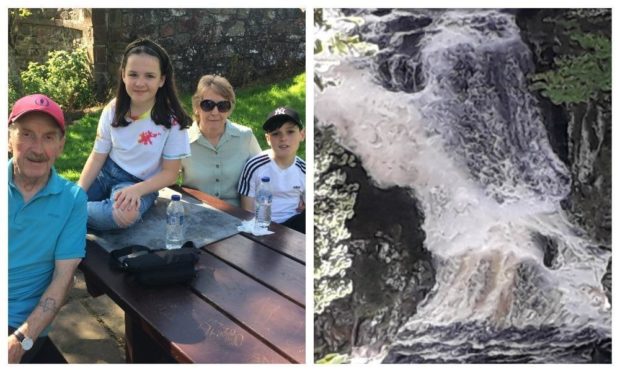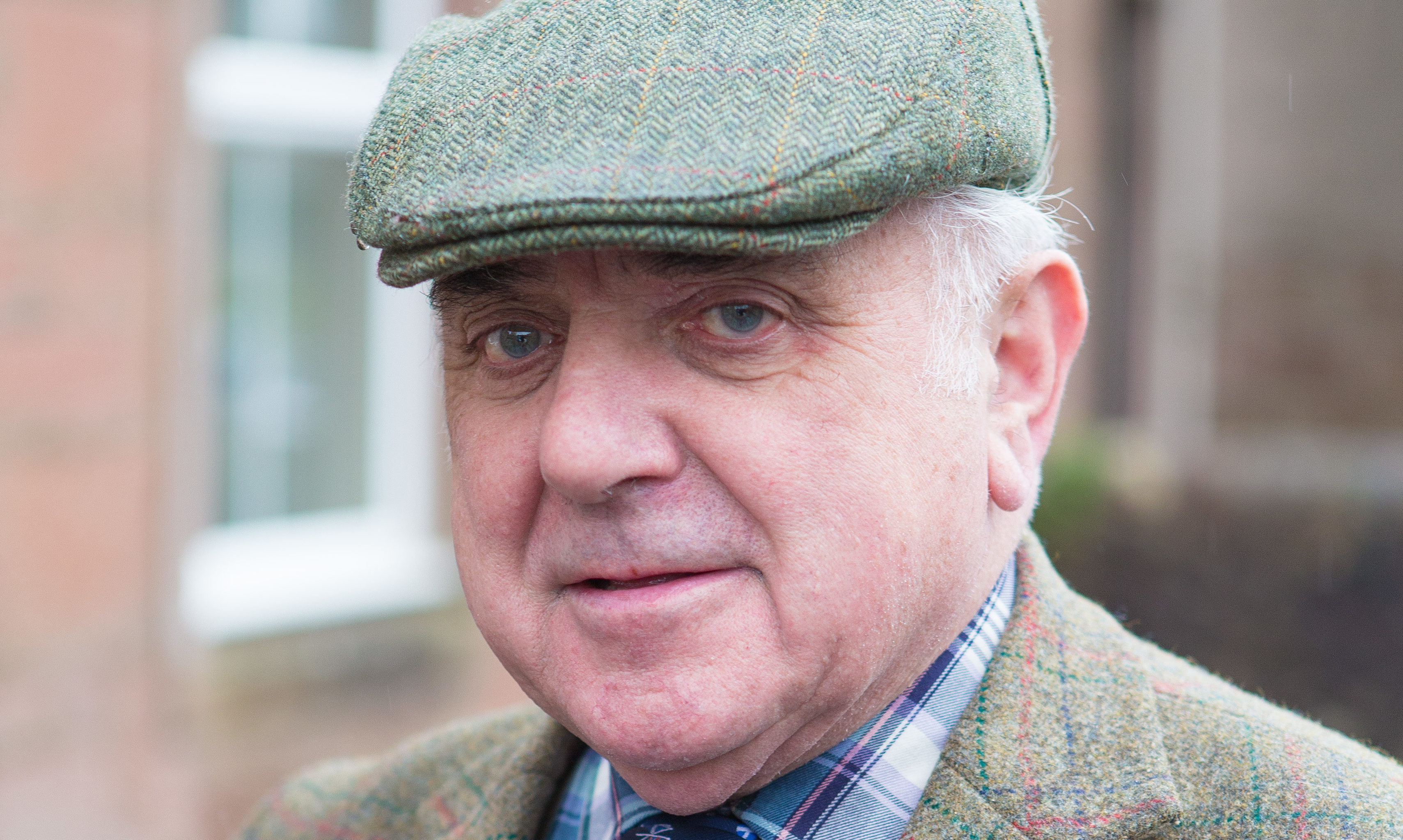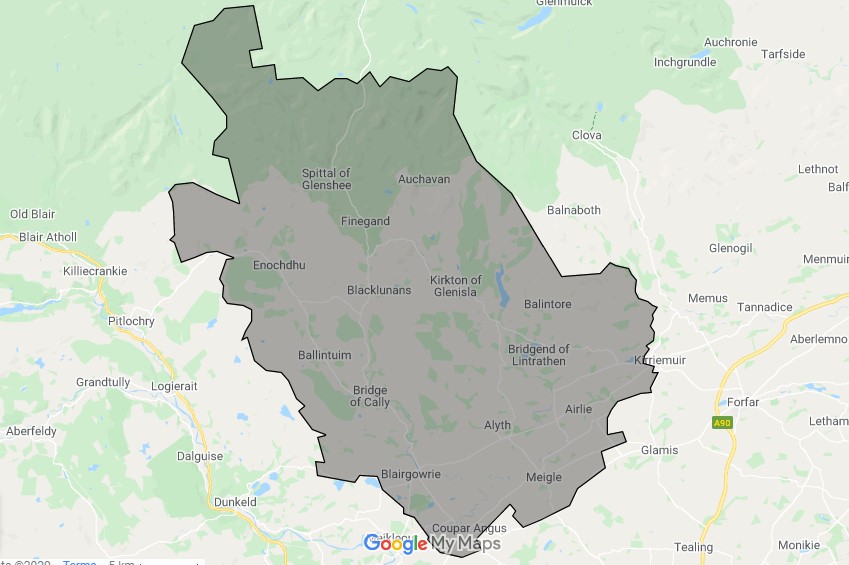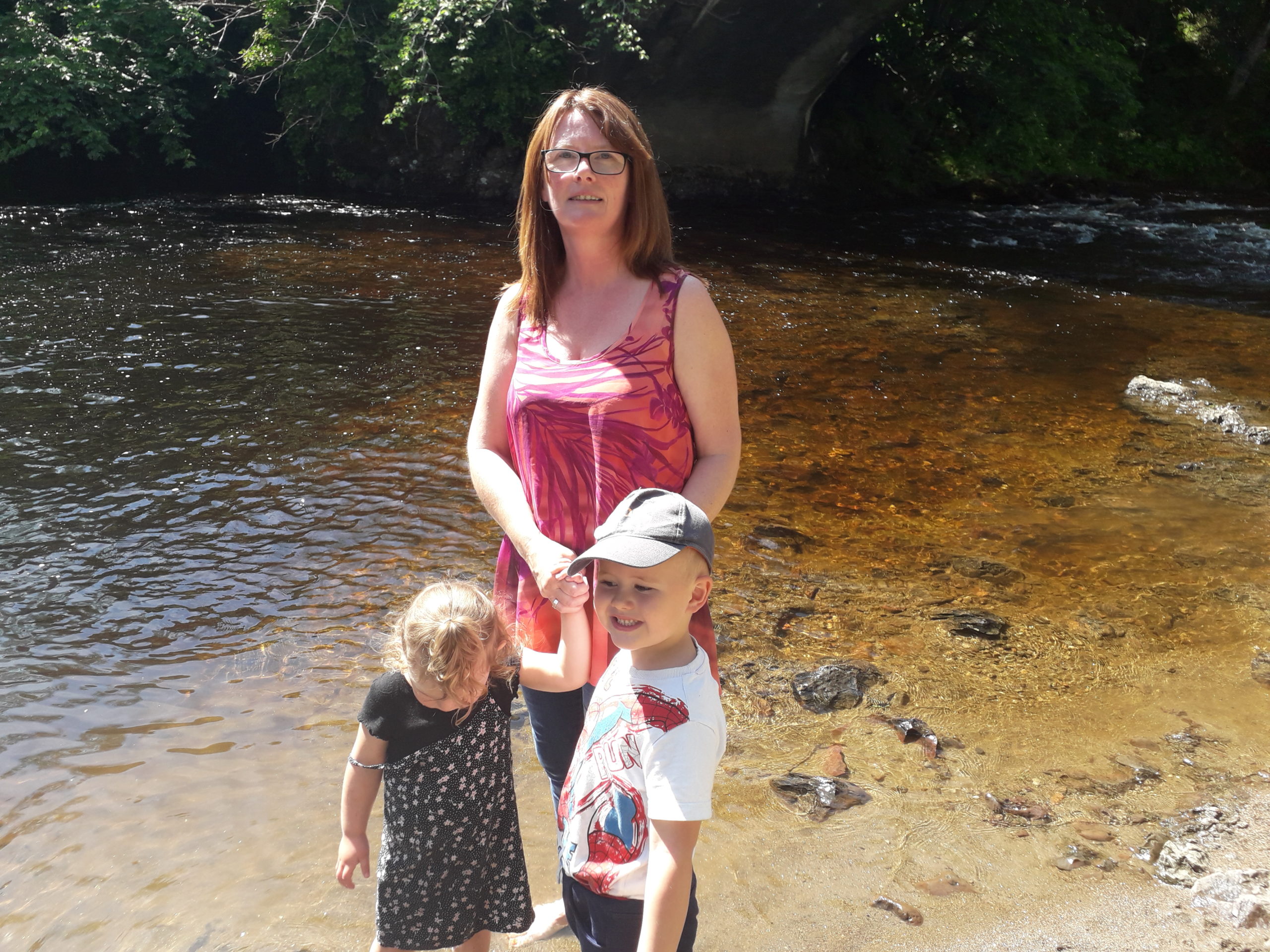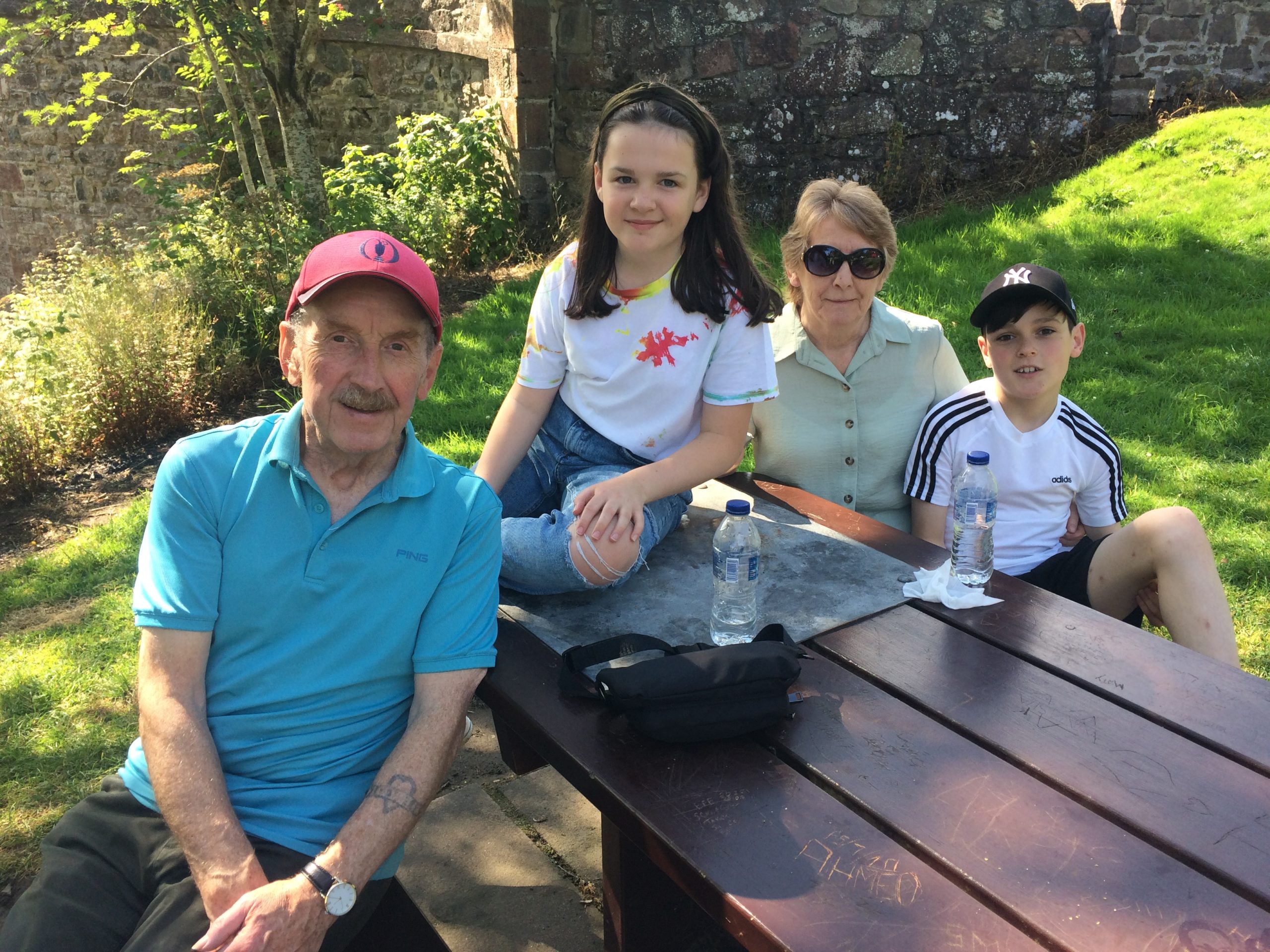For us fortunate ones living close enough to be regular visitors, a change was observed at Reekie Linn this summer.
For eons, this special stretch of water hidden behind the B954 at Bridge of Craigisla – four miles north of Alyth and 10 miles west of Kirriemuir on the westerly edge of Angus – has not only been Tayside and Fife’s most dramatic waterfall, but also one of Scotland’s finest.
Reekie Linn is actually a pair of linked falls on the River Isla, with respective drops of 6m and 18 m. When in spate the two falls merge to create a single drop of 24m, sending up a fine mist to give Reekie Linn its name. Reekie roughly translates as smoky, or misty, and Linn means a deep or dark pool.
Access is easy, a mere 10-minute walk taking visitors from the car park along a tree-lined path to a viewing area perched on a canyon some 45m above the waterfall. Unnerving as this sheer drop may be, it ensures visitors are treated to an awesome spectacle of raw nature in action.
Reekie Linn’s iconic status is confirmed by mythicism (scroll down and you will see an examination of the gorge’s links to King Arthur in the 13th century) and the fact it has a registered Scottish country dance named after it.
Despite the acclaim, there has long been a feeling among locals that Reekie Linn has been a hidden gem that only the few in the know know about.
But 2020, as it has in so much else, appears to have been a game-changer. Locals who would previously have been working, or holidaying further afield, spent our fine summer exploring overlooked marvels such as Reekie Linn.
A modest car park that used to cater for the occasional vehicle became routinely over-capacity, with overspill vehicles flooding onto the main road. The oft-desolate picnic area assumed a hive of activity ripe with families and friends soaking up the rays. A gorge where you were guaranteed solitude turned into an attraction for the many.
The secret is out but those of us who know and love this place had been doing our best to spread the word anyway.
One of those is the Provost of Angus, Cllr Ronnie Proctor, who has visited Reekie Linn with his family on numerous occasions and also taken friends from abroad to see it.
His description of this natural marvel is marvellous:
“On the north side of the road and the bridge there is the perfectly calm River Isla heading southwards to eventually join the River Tay, but then once the river flows under the bridge after a short distance it cascades with great force over the rocks and into the chasm below with a thunderous roar, emanating clouds of spray similar to smoke (reek).
“It is a great example of mother nature at her best as the waters tumble towards the Slug of Auchrannie and then into the Den of Airlie. I would go as far as saying that it is one of the celebrated waterfalls in Scotland and is visited by numerous local people and from further afield and abroad.
“During the current Covid-19 travel restrictions it is definitely worth a revisit from those who have been before and also from those who have decided on a ‘staycation’ who should pay a visit for the first time.”
‘You have to be courageous to come here after a storm’
While Reekie Linn has enchanted local people for generations, for Clare Cooper the discovery of the “dramatic” gorge came a little later in life.
In 2012 East Anglian-born Clare, 62, moved to Alyth from London having previously lived in Tanzania and Kenya.
The initial reason for the move was to be closer to her parents, who moved to the area from Africa in 1998, but so entranced was Clare with this part of the Angus/Perthshire border that it inspired her to co-found a groundbreaking museum.
With three other people, in March 2018 she set up the Cateran Ecomuseum, a “museum without walls” covering some 1,000 square km of eastern Perthshire and western Angus.
“We launched formally in November 2019 and on our website you will find 18 pre-designed itineraries which are primarily walking and cycling itineraries that will take you all over this very, very beautiful part of Scotland,” said Clare, who previously worked in the arts.
The rectangular stretch of land covered by the Cateran Ecomuseum encompasses Glenshee, Kirkmichael, Coupar Angus and Kirriemuir.
Reekie Linn is one of its most dramatic features.
“A couple of the ecomuseum’s itineraries come past Reekie Linn and you can stop off and enjoy this incredible River Isla and the enormously deep and terrifying gorge that is the Reekie Linn waterfall.
“There are six rivers that run across the ecomuseum geography. The River Isla is one of them and is the biggest tributary of the River Tay from this part of Scotland.
“It has a history of going up and down in water level – very significantly. So when there is a lot of rain in the glens you will find it probably rises six or seven feet – if not more – quite rapidly and then it also goes down quite rapidly as well. So coming to Reekie Linn after a storm you have to be quite courageous.
“It’s also very important water source for farmers of Strathmore who rely on drawing water from it during very dry periods, such as we have had this year.
“The drop of the Reekie Linn waterfall is significant and it is certainly the biggest waterfall in the eastern part of Scotland. It’s up there as one of Scotland’s most dramatic waterfalls.
“It’s very loved. If you talk to people who have visited the area and don’t necessarily live here, as well as to local people, there are many many memories of people coming here, the first time they came here, bringing special people here. It’s got an enormous affection in a lot of people’s lives.”
Reekie Linn’s breathtaking beauty attracts visitors from far and wide, which has caused problems with congestion that were amplified during lockdown.
Clare added: “We are mindful it is a working landscape. Reekie Linn has had issues with people walking over the fence into nearby farmland.
“Immediately after lockdown I noticed that people were parking on the adjacent road on a big bend. If you come here and the car park is full please don’t park on the road because it’s dangerous.
“You also have to be conscious because of how steep the gorges are. We don’t want to put people off but to encourage them to be mindful.”
‘It’s an absolutely magical spot’
A visit this summer marked the fourth time that Steve Young had been to Reekie Linn, a place that holds a special place in his heart.
The 42-year-old musician had that morning set off on the 45-minute trip from his home in Wormit, Fife, with his wife Carrie, 41, and three children for a day out with more than just natural beauty on offer.
“I first came here when I was 10 with my best friend Scott Donald and his dad Arthur. I then came back when I was about 19,” he recalled.
“Arthur died 10 to 15 years ago and when I came back here the memory of my friend’s dad was really strong, like I was still here, and it transported me back.
“I came here once as a child, once as a teenager, and this is second time since we went into lockdown.
“It’s an absolutely magical spot. Rivers and waterfalls have been associated with magical places and spiritual energy. There’s a life force here.
“It’s a perfect spot for the kids and also has an epic waterfall that is awe inspiring.”
Steve, a solo music producer under the name Hedflux, grew up in Newport-on-Tay and left Scotland for 20 years before returning recently.
He is far from the only one in his family who extracts a special feeling from this remarkable gorge.
His children – daughters Neela, 6, and Ava, 10, and son Aro, 4 – were the driving force behind this latest trip.
Steve explained: “We live in Fife and there is nowhere down there like this. The kids love it. It’s their favourite spot.
“After they got a taste of it I gave them a choice of where they wanted to go and they decided to come here.
“It’s my favourite beauty spot in the local area. A lot of people don’t know about it. My neighbours in Fife are from Dundee and they don’t know about it.”
‘I was like, ‘wow, this is really nice and peaceful’.’
With the notable exception of sports and activities involving snow, summer is the season that most attracts local people to enjoy attractions and pursuits in the great outdoors.
This was further illustrated during the coronavirus lockdown, which led to many deciding not to holiday abroad.
Throughout Tayside and Fife local people have come out in droves to explore their area, and Reekie Linn was no exception.
But this is a place for all seasons and weathers.
The main parking area abuts the north side of the River Isla where the water is calm and usually low. Here the land is flat, which lends itself to chairs and benches that were routinely filled this summer by people having a picnic or simply relaxing.
While it is pleasant there is little indication of the magnificence to be found a mere 100 metres downstream.
That spectacle – the famous Reekie Linn waterfall – is arguably better enjoyed in the winter months, when there are fewer leaves on the cliff-side to obstruct the view and the flowing water can be more ferocious.
This is how David De Gernier feels. The Kent-born 42 year old has lived in Alyth for the past 15 years but first visited Reekie Linn in 1998.
“My dad brought me up here as he was living here already,” said David. “I was like, ‘wow, this is really nice and peaceful’.
“It’s actually nice in the winter. You see more as the leaves are down and the water rises a few feet.”
David estimates he visits Reekie Linn half-a-dozen times a year but says his dad, Paul, frequents the gorge more often, enjoying the odd barbecue along the way.
David added: “I really like how peaceful it is. The sound of the waterfall is peaceful.
“My partner and kids come up here with my girlfriend’s sister and sit in and paddle.
“I have noticed it getting busier over the last eight to 10 years. Hardly anybody used to know about it but it can get packed up here now.”
Reekie Linn myth led to Paul Ramsay becoming Laird of Bamff
Paul Ramsay’s distinguished title of the Laird of Bamff owes much to Reekie Linn.
The 166-hectare Bamff estate, located a couple of miles south-west of Reekie Linn, has been owned by the Ramsay family since the year 1232, when Neish Ramsay, a doctor, was given the lands of Bamff, Fyal, Kinkeadly and Ardormie, as a reward for saving the life of his patient, King Alexander II of Scotland.
He is reputed to have removed a hairball from his stomach in an early successful operation. Paul, 74, who is the 28th generation of his family to own the estate, tells a longer story involving a magic potion made of a white snake caught at the cave behind the Reekie Linn waterfall.
The year was 1232. Neish, as a young man, as a medical student, studied in Bologna or somewhere like that. He was asked by his master to go back to Scotland to find the Reekie Linn in Angus and to wait there for the white serpent that lived in the cave just by the waterfall.
So he travelled all the way home to find the Reekie Linn and he went there and he waited and in due course one moonlit night the serpent appeared and so Neish, well prepared, jumped out of the serpent, quickly killed it and cut it into pieces. Then he had to travel all the way back to Italy, or wherever his university was.
You can imagine that he probably had to dry a bit of the snake first. You can imagine that he had to hang it out, or any number of things and then away he went and after many months of travel he arrived back at his university.
And there was his master – the professor, the doctor, the magician, whatever he was – who instructed Neish to boil up the serpent in the great laboratory cauldron. And he was to see and not fall asleep when he was doing this. So away he went and Neish made the preparation and put the cauldron on the fire and put all the bits of stuff in it.
The day was hot and the fire was hot so eventually he fell asleep and the next thing he knew the cauldron was boiling over. So he rushed to take the cauldron off the fire because it must not boil over. As he did this, a great gobit of snake stock landed on his hand and, as he took it away from the cauldron, having put it down for safety, he licked his thumb and fingers. As it happened the laboratory cat was walking along and he realised that he could see its skeleton and he thought ‘wow, this is potent stuff, I’d better take a look for myself’.
The wizard, his boss, was very pleased. By this time the smell of scolding snake soup had dissipated – and he was very pleased with what Neish had done. Neish filed and kept the substance.
Time passed and in present day parlance Neish would have earned his PHD and so he set off for home. Well, he went over the Alps, through France and eventually took ship and arrived in the port of Nice. He was delighted to be back at home. But as he arrived on shore he realised that everybody looked upset.
He asked ‘what’s wrong’? They said ‘did you no’ hear the King Arthur is no’ well and likely to die’?
Neish thought that with his new skill and knowledge he could perhaps help the king. So he went to the palace – or maybe he was in Edinburgh, or Dunfermline, who can say where the king was?
At the royal palace were all the medical people in a state of gloom and dismay. Neish went to them and introduced himself. He said, ‘I have just come from Bologna and I am a student’. They said, ‘that’s good but we have tried everything we can and nothing is working, but as you are here you should have a go’.
So Neish was taken to the king, and there he was, Alexander II, on his bed groaning in a terrible state. So Neish asked the other people to leave. He took out the file, licked the substance which enabled him to see into the king’s stomach – it was like an ultrasound – and could see that a hairball was blocking the king’s stomach and he knew what he had to do.
He said it demanded immediate abdominal surgery and asked if they could prepare his highness, and they did.
The medical world in those days did have a number of anaesthetics. They found various things that could be used for that type of thing.
They rendered the king unconscious. Neish made the incision into the abdominal cavity and cut into the stomach. He opened it out very carefully and lifted out the hairball. Then, calling for needles he stitched up his stomach. He said the king should be kept well hydrated.
Eventually the king woke up and he felt so much better. The nurses took him gruel and light soups, strengthening chicken broth. They also took him some something similar to champagne.
The king was delighted that he had survived. He asked, ‘who has done this’? The answer was Neish so he summoned him and asked ‘ how can I reward you for the wonderful thing you have done’?
Neish said ‘I was amazed by the wonderful country just near Reekie Linn and I would be so grateful to have some of that. The king said, ‘Well, yes, I can arrange that because that is part of my royal domain and just a chunk out of my forest of Alyth. And then his clerks made up a charter signed by various people to give him the land.
On October 9 1232 Alexander II made a charter dating October 9 from Aberdeen to grant the land of Bamff to his doctor Nagistar Ramsay.
The story is a metaphor for someone who is a wise man.
‘I never realised it was going to be so high and steep’
Even if you know what to expect ahead of a trip to Reekie Linn, you don’t know what to expect.
Such is the sheer scale and power of the waterfall that it seldom fails to surprise those making their first visit.
One day last summer, childminder Tracey Thomas, 51, was looking after Timur Orlov, 4, and Mila-Rose Ritchie, 2, and decided to go on a group trip to the Angus attraction having seen its wonder on social media.
Tracey, who lives in Dundee, soon discovered that what you see on a screen can tell you only a fraction of what you will experience in real-life.
“I heard about it on social media and my friend also suggested coming here,” she said.
“I never realised it was going to be so high and steep. It’s quite a narrow path at the top.”
At least the picnic area close to the car park provides a different dimension to the precarious cliff further along.
“Because of lockdown we have been taking the kids to quieter places where you can be socially distance,” added Tracey.
A day trip to Reekie Linn was a family affair for the McLeod family.
William, 78, and Doreen, 75, enjoyed a relax in the sun with twin grandchildren Erin and Daniel after travelling up from Dundee.
William said: “In Dundee there’s nowhere like this. If we come back we will bring a picnic next time.”
Daniel said: “I was here a couple of weeks ago. My mum took us and it was fun.”
Quiet path provides antidote to congestion
An antidote for fans of Reekie Linn who may have been put off by its surge in popularity is a secondary path south of the waterfall.
The north is where the car park, picnic area and main footpath is located but before you reach the Bridge of Craigisla, heading north on the B954 from Alyth, is a discretely placed sign directing you to Reekie Linn.
The grassy track skirts alongside a high wall bounding the grounds of Craigisla House and heads through a corridor of trees and rhododendron, before you eventually find a viewpoint above the falls.
Here, you can find more privacy and actually get closer to the waterfall itself. James Carron writes in depth about this route in his blog.
Dundonians Clare Cromar, 39, and Vicky Franks, 41, explored this route with children Jessica Cromar, 11, Emma Cromar, 9, Amaya Franks, 9, Arthur Franks, 9, and Brooke Hays, 9.
Clare said: “This is the second time we have been here. We walked along the other side of the path the first time and now the second time we came this way. We found this a much better path.”
Vicky said: “Reekie Linn is close to Dundee but you still feel as though you are in the middle of nowhere.”
